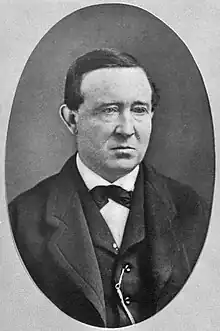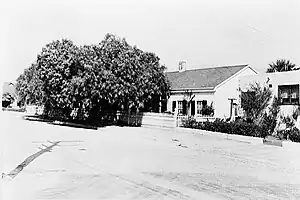Francis Doud
Francis Doud (January 20, 1820 – December 3, 1910) was a California pioneer of 1849, a veteran soldier of the Mexican–American War, who enlisted in the army "to fight the Indians".[1] He established the Doud House in ca. 1852, and acquired 5,000 acres (2,000 ha) along the seacoast south of Monterey, California, in 1891 to create the Doud Ranch.[2]
Francis Doud | |
|---|---|
 Francis Doud (1820-1910) | |
| Born | January 20, 1820 |
| Died | 3 December 1910 (aged 90) |
| Occupation(s) | California pioneer, soldier, builder |
| Spouse | Ann Kelleher |
| Children | 6 |
He was known as a "prominent capitalist".[3]
Early life
Doud was born on January 20, 1820, in the town of Castlebar, Ireland. His parents were James Doud (b.1789) and Winifred Churchill (b. 1785). Doud left his homeland at age sixteen (1935) and emigrated to New York City, where he briefly visited relatives.[1]
He married Ann Kelleher (1821–1896) of Ireland on Lockport, New York, on September 14, 1845. They had six children: Frank, Nellie, Mary, Thomas, Martin and Edward. Thomas (1854–1929), who was the father of James Cooper Doud (1902–1984), a real-estate developer in Carmel-by-the-Sea, California. He built the Doud Building in 1932 and the Doud Arcade, a two-story commercial building built in 1961.[4]
Military career
In 1838, Doud enlisted in the United States Army with the mission to fight the Native American peoples. He served in the Seminole Wars (1835-42) in Florida for four years. Doud then served in the Mexican–American War under General Bennet C. Riley. Wounded during the Siege of Veracruz, a key Mexican beachhead seaport of Veracruz, and later at Battle of Cerro Gordo, these injuries ultimately led to his honorable discharge in 1847.[5] His achievements were recognized through a bronze medal crafted from the metal of brass fieldpieces used in the battles at Veracruz. The Mexican Veteran Association issued the medal, bearing the year of 1847.[1] His wife was with him all through the Mexican war.[3]
As the Mexican War drew to a close and the United States Army took control of Monterey, Doud left New York on January 26, 1849, and traveled with his wife, Anna, and their son Francis Jr., six months aboard the steamer Orpheus. They arrived in San Francisco on July 8, 1849 and then moved to Monterey, California.[6][3][5] Doud was the custodian of government property at the Presidio of Monterey.[1]
Doud reunited with his former leader, General Riley, on July 8, 1849, coinciding with Riley's appointment as the 7th military governor of California. Riley played a role in laying the groundwork for a civilian administration and the attainment of statehood for California. Within this period, the 1849 California Constitution Convention convened at Colton Hall. Doud assumed the roles of both sergeant-at-arms and messenger during the Constitutional Convention from August 10 to September 30, 1849.[7][6][5]
Private life
In Monterey, transitioned into private life and ventured into the realm of business, where he built the first butcher shop with lumber that came around the Horn of Africa. He operated a meat market within the town.[1][8]
During the California Gold Rush, Doud ventured to the mines situated in Mariposa, California, during the winter months. By June 1950, he had returned to Monterey, where he acquired his initial real estate holding from the former Mexican War officer, Major Edward S. Canby, for a sum of $400 (equivalent to $14,070 in 2022). Although the parcel was modest in size, its value was elevated due to its close proximity to the Custom House.[5]
On February 26, 1873, Doud became a member of the Society of California Pioneers, that had been established in 1850.[6] He was a member of the Monterey Chamber of Commerce where he contributed to the advancement of the city. Around 1910, he gave the organization $50 (equivalent to $1,570 in 2022).[2]
Doud House

During the 1850s, Doud and his family relocated their initial residence to the rear of the land they owned and constructed the larger Doud House, situated at the present-day 117 Van Buren Street. Historical accounts suggest that Doud initiated the building process for the current residence on the land he had been residing on since 1852, during the latter part of the 1860s.[6]
The Doud House, designed in the New England Vernacular-style, is a single-story rectangular home. Its façade includes an open veranda that spanning the width of the white clapboard structure. Double sash windows are hung with ornamental shutters. Access to the veranda is granted via a set of straight double stairs with a picket railing. The building has a gabled roof composed of composition shingles, and a picket fence encloses the property. In 1976, an additional 8 square feet (0.74 m2) of floor space was incorporated.[5]
Upon Doud's death in 1910, ownership of the family residence transferred to his daughter, Mary Doud. Following Mary's death in 1933, the property was bequeathed to all family members in undivided portions. Nettie Doud Baker occupied the residence, as did her uncle, Frank Doud, until his passing in 1933. Subsequently, Nettie Doud Baker, who held ownership of nearly half of the property, passed away in 1966. The Monterey Urban Renewal Agency engaged in negotiations to acquire the property from the Doud estate. Following advocacy by the Monterey History and Art Association, the property was eventually bestowed upon the Association in 1969 and embarked on an extensive restoration effort.[5][9]
The gardens surrounding the house were dedicated as the Carmel Martin Memorial Garden in 1973.[10]
Rancho San José y Sur Chiquito

Doud engaged in stock-raising and farming. In August 1891, he purchased 5,000 acres (2,000 ha) of the Rancho San José y Sur Chiquito property along the seacoast south of Monterey from Josefa Alvardo de Escobar for $1,000 (equivalent to $32,570 in 2022). With this land he created the Doud Ranch, which ran cattle until the early 1950s.[1][11]
The family's wood-frame ranch house burned to the ground in the 1960s. The State acquired its first parcel of the property in 1980. The Garrapata State Park (Garrapata being Spanish for tick) was classified a state park in 1985.[12]
Death and legacy
Doud died in his home on December 3, 1910, at the age of 90.[13] The family residence served as the starting point for the funeral services, followed by a procession to the San Carlos Church, where a high mass was conducted. Doud was buried at the San Carlos Cemetery in Monterey. The inscription on his grave says: "A native of Castle Bar, County Mayo, Ireland aged 90 years."[2]
The Online Archive of California contains the collection known as the Francis Doud Papers that comprises various records spanning the years 1847 to 1919, a significant number of which are accompanied by typewritten duplicates. Among the contents are two letters of correspondence addressed to Doud, one letter directed to Francis Doud Jr. concerning his father's death, a duo of letters concerning property matters in Monterey, California, discreetly alluding to Doud's role, an excerpt from a Berlin newspaper detailing the 1906 San Francisco earthquake, and a letter discussing an unidentified wounded soldier from the Mexican War.[6]
The Monterey Chamber of Commerce said this about the death of Doud: "Whereas, We have heard with profound sorrow of the death of Francis Doud, a respected citizen of this city and an esteemed member of this organization; therefore be it Resolved, that he business of the Monterey Chamber of Commerce be now suspended, that opportunity may be given for tribute to the memory of the late Francis Doud and as a particular mark of respect to his memory and in recognition of his many sacrifices for this county, his family and the community in which he lived... Resolved, that when this meeting adjourn it do so with respect to the memory of our late member Francis Doud. Resolved, that a copy of these resolutions be transmitted to the family of the late Francis Doud, and that a copy of these resolutions be spread upon the minutes of this meeting."
See also
References
- Barrows, Henry D. (1893). A memorial and biographical history of the coast counties of Central California. Chicago: Lewis Publishing Company. p. 423. Retrieved 2023-08-03.
- "Mr. Doud's Funeral". Monterey Daily Cypress and Monterey American. Monterey, California. 6 Dec 1910. p. 1. Retrieved 2023-08-03.
- "Death of a Monterey Pioneer". The Los Angeles Times. Los Angeles, California. 14 Jan 1896. p. 3. Retrieved 2023-08-04.
- Dramov, Alissandra (2019). Historic Buildings of Downtown Carmel-by-the-Sea. Carmel-by-the-Sea, California: Arcadia Publishing. pp. 45, 85, 92. ISBN 9781467103039. Retrieved 2022-06-14.
- Jane Anne Wileman (August 1977), "DPR 523 Form Historic Resources Inventory", Department of Parks and recreation, Monterey, California, retrieved 2023-08-07
- "Finding aid of the Francis Doud Papers C058832". Online Archive California. Retrieved 2023-08-03.
- "Colton Hall". CA State Parks. Retrieved 11 January 2021.
- Hunt, Rockwell Dennis (1926). California and Californians Volume 4. Lewis Publishing Company. pp. 78–79. Retrieved 2023-08-03.
- "Doud House". Monterey History & Art Association. Monterey, California. Retrieved 2023-08-03.
- Norkunas, Martha K. (July 1993). The Politics of Public Memory. State University of New York Press. ISBN 9781438414829. Retrieved 2023-08-03.
- "Real Estate Transactions". The Californian. Salinas, California. 12 Aug 1891. p. 2. Retrieved 2023-08-04.
- "Garrapata State Park" (PDF). www.parks.ca.gov. California State Parks. Archived (PDF) from the original on 5 January 2021. Retrieved 11 May 2018.
- "Mexican War Vetran Dies At Monterey". San Francisco Chronicle. San Francisco, California. 4 Dec 1910. p. 29. Retrieved 2023-08-25.
External links
- The Doud House Archive
- Monterey State Historic Park
- Doud House Tract
- National Historic Landmark District and Downtown Area Context Statement and Reconnaissance Survey
- City Of Monterey Master Historic List H-1 H-2 Properties